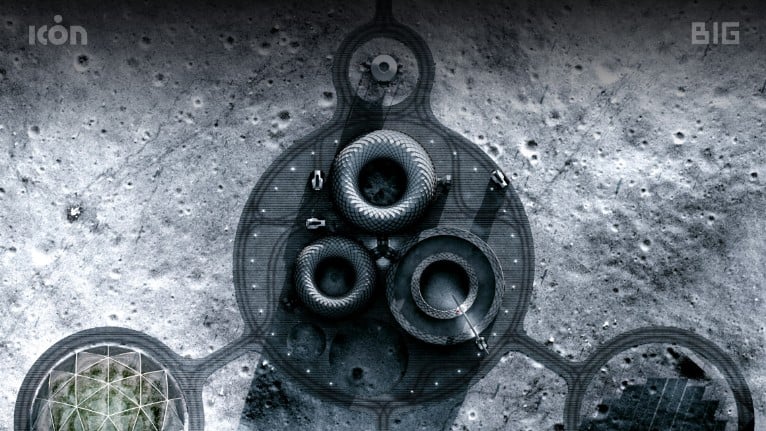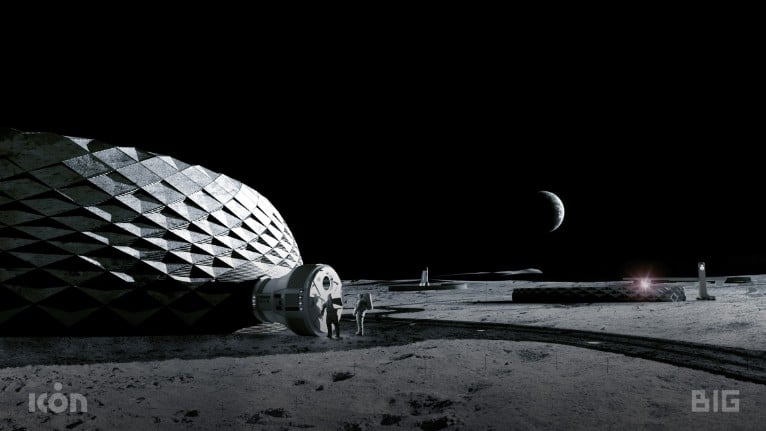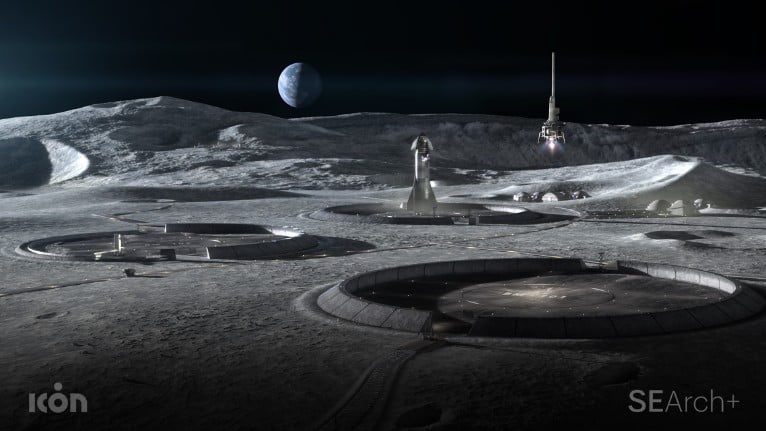
BIG - Bjarke Ingels Group teams up with ICON, developer of advanced construction technologies including robotics, software and building materials, and with SEArch+ (Space Exploration Architecture), to work with NASA on beginning research and development of a space-based construction system that could support future exploration of the Moon.
NASA has signaled that, through the Artemis program, the Moon will be the first off-Earth site for sustainable surface exploration. BIG has partnered with ICON to begin designing Project Olympus, a sustainable lunar habitat that will be the first human foray into extra-terrestrial construction with robust structures that provide better thermal, radiation, and micrometeorite protection than metal or inflatable habitats can offer. From landing pads to habitats, these collective efforts together with NASA and SEArch+ are driven by the need to make humanity a spacefaring civilization.
"To explain the power of architecture, "formgiving" is the Danish word for design, which literally means to give form to that which has not yet been given form. This becomes fundamentally clear when we venture beyond Earth and begin to imagine how we are going to build and live on entirely new worlds. With ICON we are pioneering new frontiers – both materially, technologically and environmentally. The answers to our challenges on Earth very well might be found on the Moon,” said Bjarke Ingels, Founder and Creative Director, BIG-Bjarke Ingels Group.

In partnership with NASA’s Marshall Space Flight Center in Huntsville, Alabama, ICON will test lunar soil simulant with various processing and printing technologies. The tests will help design, develop, and demonstrate prototype elements for a possible future full-scale additive construction system that could print infrastructure on the Moon. The new partnership builds upon technology ICON demonstrated during NASA’s 3D Printed Habitat Challenge in 2018.
“Building humanity’s first home on another world will be the most ambitious construction project in human history and will push science, engineering, technology, and architecture to literal new heights,” said Jason Ballard, Co-founder and CEO of ICON. “NASA’s investment in space-age technologies like this can not only help to advance humanity’s future in space, but also to solve very real, vexing problems we face on Earth. We are honored to begin our research and development on ICON’s ‘Project Olympus’ and the ‘Olympus Construction System.’”

Recognized on a global scale for innovative ‘human-centered’ designs for space exploration, SEArch+ has over a decade-long association with NASA’s Johnson Space Center Human Habitability Division, Langley Research Center, Ames Research Center and leading aerospace corporations.
“Ensuring the safety of astronauts is primary to our work at SEArch+. The creation of aspirational spaces that enrich and celebrate human life is central to our role as architects and designers as is making places that will allow people to thrive on distant planets. At SEArch+, we believe that 3D printing with indigenous materials is not only a fantastic practical solution but will prove to be critically vital to our species’ survival both here on Earth and in Outer Space,” said SEArch+ Co-founders.

“Building on our experience with BIG’s Mars Science City, we are working to develop the first permanent structure on the Moon resilient to the hostile lunar environment where the cost of payload transportation requires rigorous efficiency. We have explored various building forms ideal for containing atmospheric pressure and optimized for protection from cosmic and solar radiation. The habitat will be designed with the inherent redundancy required for extraterrestrial buildings, while also using groundbreaking robotic construction that uses only in-situ resources with zero waste left behind. With the technologies and efficiency parameters developed for the construction of extraterrestrial buildings, Project Olympus will also help us to build sustainably on planet Earth as we strive to reduce the carbon footprint of the built environment.” Martin Voelkle, Partner, BIG.
Project Olympus is BIG’s second project in outer space following Mars Science City, currently being developed in Dubai as a prototype for exploring the building technologies that humanity would need to reside and thrive on the Red Planet. Like Mars Science City, Project Olympus will address 8 of the 17 UN Sustainable Development Goals, related to the built environment of our Blue Planet.




 3
3
comment